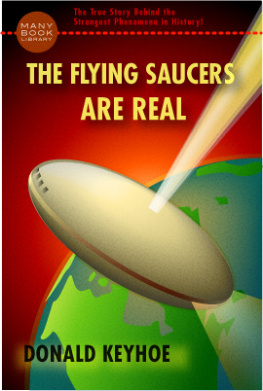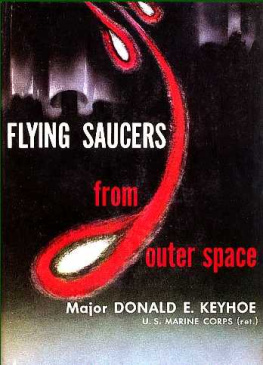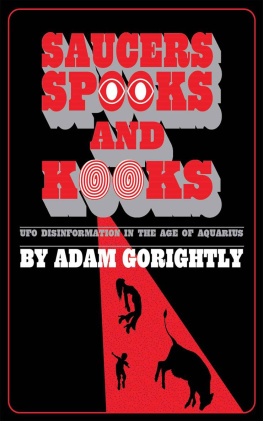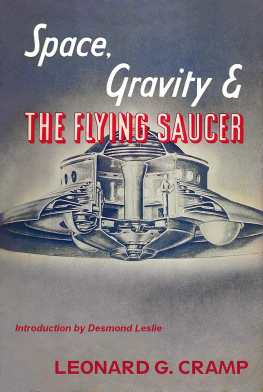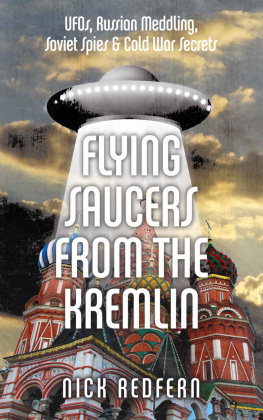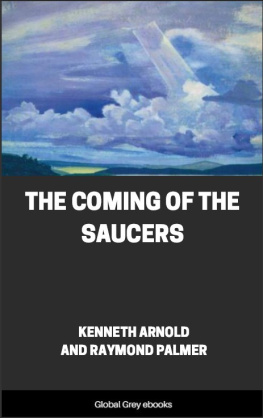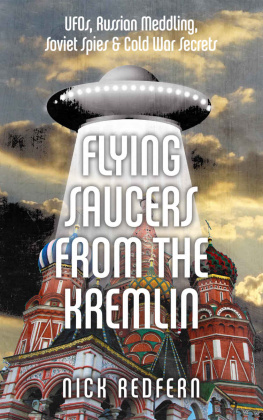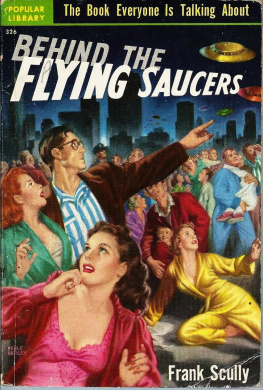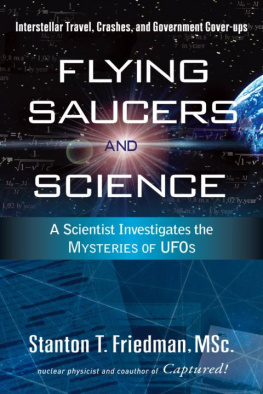Donald Keyhoe - The Flying Saucers Are Real
Here you can read online Donald Keyhoe - The Flying Saucers Are Real full text of the book (entire story) in english for free. Download pdf and epub, get meaning, cover and reviews about this ebook. year: 0, genre: Detective and thriller. Description of the work, (preface) as well as reviews are available. Best literature library LitArk.com created for fans of good reading and offers a wide selection of genres:
Romance novel
Science fiction
Adventure
Detective
Science
History
Home and family
Prose
Art
Politics
Computer
Non-fiction
Religion
Business
Children
Humor
Choose a favorite category and find really read worthwhile books. Enjoy immersion in the world of imagination, feel the emotions of the characters or learn something new for yourself, make an fascinating discovery.
- Book:The Flying Saucers Are Real
- Author:
- Genre:
- Year:0
- Rating:3 / 5
- Favourites:Add to favourites
- Your mark:
- 60
- 1
- 2
- 3
- 4
- 5
The Flying Saucers Are Real: summary, description and annotation
We offer to read an annotation, description, summary or preface (depends on what the author of the book "The Flying Saucers Are Real" wrote himself). If you haven't found the necessary information about the book — write in the comments, we will try to find it.
The Flying Saucers Are Real — read online for free the complete book (whole text) full work
Below is the text of the book, divided by pages. System saving the place of the last page read, allows you to conveniently read the book "The Flying Saucers Are Real" online for free, without having to search again every time where you left off. Put a bookmark, and you can go to the page where you finished reading at any time.
Font size:
Interval:
Bookmark:
by Donald Keyhoe
New York
Fawcett Publications, 1950
{scanned at sacred-texts.com, March 2002}
This book is in the public domain because it was not renewed in a timely fashion at the US Copyright Office, as required by law at the time.
{p. 3}
To Helen,
with love
ON APRIL 27, 1949, the U.S. Air Force stated:
"The mere existence of some yet unidentified flying objects necessitates a constant vigilance on the part of Project 'Saucer' personnel, and on the part of the civilian population.
"Answers have been--and will be--drawn from such factors as guided missile research activity, balloons, astronomical phenomena.... But there are still question marks.
"Possibilities that the saucers are foreign aircraft have also been considered.... But observations based on nuclear power plant research in this country label as 'highly improbable' the existence on Earth of engines small enough to have Powered the saucers.
"Intelligent life on Mars... is not impossible but is completely unproven. The possibility of intelligent life on the Planet Venus is not considered completely unreasonable by astronomers.
"The saucers are not jokes. Neither are they cause for alarm."[1]
On December 27, 1949, the Air Force denied the existence of flying saucers.[2]
On December 30, 1949, the Air Force revealed part of a secret Project "Saucer" report to members of the press at Washington. The official report stated:
"It will never be possible to say with certainty that any individual did not see a space ship, an enemy missile, or some other object."
Discussing the motives of possible visitors from space, the report also stated:
"Such a civilization might observe that on Earth we now have atomic bombs and are fast developing rockets. In view of the past history of mankind, they should be
[1. Project "Saucer" Preliminary Study of Flying Saucers.
2. Air Force Press Release 629-49.'
{p. 6}
alarmed. We should therefore expect at this time above all to behold such visitations."
(In its April 22 report, Project "Saucer" stated that space travel outside the solar system is almost a certainty.)
On February 22, 1950, the Air Force again denied the existence of flying saucers. On this same date, two saucers reported above Key West Naval Air Station were tracked by radar; they were described as maneuvering at high speed fifty miles above the earth. The Air Force refused to comment.
On March 9, 1950, a large metallic disk was pursued by F-51 and jet fighters and observed by scores of Air Force officers at Wright Field, Ohio. On March 18, an Air Force spokesman again denied that saucers exist and specifically stated that they were not American guided missiles or space-exploration devices.
I have carefully examined all Air Force saucer reports made in the last three years. For the past year, I have taken part in a special investigation of the flying-saucer riddle.
I believe that the Air Force statements, contradictory as they appear, are part of an intricate program to prepare America--and the world--for the secret of the disks.
{p. 7}
Donald E. Keyhoe, who relates here his investigation of the flying saucers, writes with twenty-five years of experience in observing aeronautical developments.
He is a graduate of the U.S. Naval Academy at Annapolis. He flew in active service with the Marine Corps, managed the tour of the historic plane in which Bennett and Byrd made their North Pole flight, was aide to Charles Lindbergh after the famous Paris flight, and was chief of information for the Aeronautics Branch, Department of Commerce.
{p. 5}
IT WAS A strange assignment.
I picked up the telegram from my desk and read it a third time.
NEW YORK, N. Y., MAY 9, 1949
HAVE BEEN INVESTIGATING FLYING SAUCER MYSTERY. FIRST TIP HINTED GIGANTIC HOAX TO COVER UP OFFICIAL SECRET. BELIEVE IT MAY HAVE BEEN PLANTED TO HIDE REAL ANSWER. LOOKS LIKE TERRIFIC STORY. CAN YOU TAKE OVER WASHINGTON END?
KEN W. PURDY, EDITOR, TRUE MAGAZINE
I glanced out at the Potomac, recalling the first saucer story. As a pilot, I'd been skeptical of flying disks. Then reports had begun to pour in from Air Force and airline pilots. Apparently alarmed, the Air Force had ordered fighters to pursue the fast-flying saucers. In one mysterious chase, a pilot had been killed, and his death was unexplained. That had been seventeen months ago. Since then, the whole flying-saucer riddle had been hidden behind a curtain of Air Force secrecy.
And now, an assignment from True magazine on flying saucers.
Twenty-four hours later, I was in Ken Purdy's office.
"I've had men on this for two months," he told me. "I might as well warn you, it's a tough story to crack."
"You think it's a Russian missile?" I asked him. "Or an Air Force secret?"
"We've had several answers. None of them stacks up. But I'm positive one was deliberately planted when they found we were checking."
He told me the whole story of the work that had been done by the staff of True and of the reports sent in by competent writers. The deeper he delved into the mystery, the tougher the assignment got. The more I learned about flying saucers, the less I knew.
"There's one angle I want rechecked," Purdy said.
"You've heard of the Mantell case?"
{p. 8}
I nodded.
"O.K. Try to get the details of Mantell's radio report to Godman Tower. Before he was killed, he described the thing he was chasing--we know that much. Project 'Saucer' gave out a hint, but they've never released the transcript. Here's another lead. See if you can find anything about a secret picture, taken at Harmon Field, Newfoundland--it was around July 1947. I'll send you other ideas as I get them."
Before I left, Purdy wished me hick and told me that he would work in closest harmony with me.
"But watch out for fake tips," he said. "You'll probably run into some people at the Pentagon who'll talk to you 'off the record.' That handcuffs a writer. Look out they don't lead you into a blind alley. Even the Air Force statements and the Project 'Saucer' report contradict each other."
For six months, I worked with other investigators to solve the mystery of the disks. We checked a hundred sighting reports, frequently crossing the trail of Project "Saucer" teams and F.B.I. agents. Old records gave fantastic leads. So did Air Force plans for exploring space. Rocket experts, astronomers, Air Force officials and pilot gave us clues pointing to a startling solution. Many intelligent persons--including scientists--believe that the saucers contain spies from another planet.
Font size:
Interval:
Bookmark:
Similar books «The Flying Saucers Are Real»
Look at similar books to The Flying Saucers Are Real. We have selected literature similar in name and meaning in the hope of providing readers with more options to find new, interesting, not yet read works.
Discussion, reviews of the book The Flying Saucers Are Real and just readers' own opinions. Leave your comments, write what you think about the work, its meaning or the main characters. Specify what exactly you liked and what you didn't like, and why you think so.

